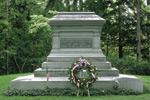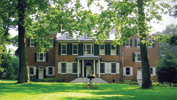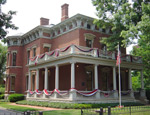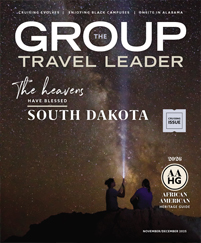After leaving office, President Rutherford B. Hayes took a daily interest in the upkeep of the grounds at his Spiegel Grove estate in Fremont, Ohio, maintaining detailed journals and often helping do the work himself.
“He would get out and do some of the pruning,” said Tom Culbertson, executive director of the Rutherford B. Hayes Presidential Center. “Sometimes, he got really bad poison ivy.”
Many sites around the country not only preserve the history of the 43 men who have been president of the United States, but also help put a human face on the historic figures who have occupied the highest office in the land, especially the lesser-known 19th-century presidents.
Visitors can learn about a president who loved the 19th-century equivalent of a CD player, one who installed two fishing ponds on his estate after leaving office and one who so loved sauerkraut that his presidential site sponsors an annual sauerkraut festival.
“At its best, history puts a recognizable face on events and people who might otherwise be reduced to academic shorthand. Sometimes, it’s the personal detail, not the great deed, that makes the connection,” writes presidential historian Richard Norton Smith in an essay for an online itinerary of presidential sites sponsored by the National Park Service.
“There is no substitute for being there. No video or Web site, however, interactive, can match the authenticity or emotional engagement of the real thing.”
Rutherford B. Hayes Presidential Center
Fremont, Ohio
Groups don’t need to go to the extreme of getting poison ivy to get a “feel” for Hayes, who was president from 1877 to 1881. The Hayes Presidential Center, which consists of his 31-room brick house, a separate 93-year-old museum and library — the nation’s first presidential library — his tomb and 25 acres of walking trails, provides numerous opportunities to learn about the nation’s 19th president.
 |
| The Rutherford B. Hayes Presidential Center includes Hayes’ 31-room brick house, above. The museum has exhibits, below, about the career of Hayes, who is buried on the grounds, right.
Courtesy Rutherford B. Hayes Presidential Center |
On guided tours of the house, Culbertson said, “rather than talking about objects as such, we talk about how the family and the president used the rooms. We try to get people to know them [Hayes and his wife, Lucy] and the family.”
The first floor of the house is being renovated to more accurately reflect the decor when Hayes lived there. The upper floors will continue to be used to interpret his family, who lived in the house until 1965.
 |
| Courtesy Rutherford B. Hayes Presidential Center |
The museum features displays, exhibits and personal artifacts that trace Hayes’ rise to prominence as a lawyer and a Civil War general and his election in the disputed 1876 presidential election.
 |
| Courtesy Rutherford B. Hayes Presidential Center |
Culbertson said it is unfortunate that people mainly remember Hayes for the election, where he failed to win the popular vote and was named the winner by a controversial presidential election commission.
“Even if you paid attention in American history class in high school or college, each president from Grant through McKinley gets a couple of paragraphs at best,” said Culbertson. “What they write about him is he didn’t get the popular vote.
“We don’t leave the impression he should be put on Mount Rushmore, but he was a middle-of-the-road, good president back in a time when the president’s influence was much more limited.
|
Presidential sites online The National Park Service, in partnership with the White House Historical Association and the National Conference of State Historic Preservation Officers, has developed an itinerary of 75 historic places associated with American presidents. The itinerary’s Web site notes: “These powerful tangible links to the presidents tell their stories and illuminate their achievements and impact on the office and the nation, bringing several centuries of American history to life.” There are descriptions of each site with illustrations and information and maps on how to visit. A Learn More section provides links to relevant Web sites, such as tourism sites with information about cultural events and activities, other things to see and do, and dining and lodging possibilities. Two essays by noted presidential historians augment the itinerary: “Introduction to the Presidents: Every Leader From Washington to Bush” by Michael Beschloss and “Being There: Encountering America’s Presidents” by Richard Norton Smith. The itinerary, which can be viewed online or printed, is the 47th in the ongoing Discover Our Shared Heritage Travel program, an initiative by the Department of the Interior to promote public awareness of history and encourage visits to historic places throughout the country. |
“He was a good, morally upstanding, well-educated family man who was intent to be as good a governor, congressman and president as he could,” said Culbertson. “He felt satisfied he had been. He is someone you don’t have to be ashamed of.”
Martin Van Buren National Historic Site
Kinderhook, N.Y.
You get different views of Martin Van Buren, the nation’s eighth president, depending on which guide leads you through his 36-room home, Lindenwald.
“Every guide writes [his or her] own outline,” said Dawn Olsen, a national park ranger at the Martin Van Buren National Historic Site. “We have Van Buren as a father and grandfather, as a politician and as a gentleman farmer.
“I like to use 1850. Even though he lived here 21 years, that was when an addition to the house was completed, doubling it in size. His youngest son and his family were joining the president and his family here.”
The renovations transformed the house from an 18th-century Georgian house into a then fashionable Italian villa with a four-story brick tower.
The hourlong tours include three floors. “The furnishings are a mixture,” said Olsen. “Some belonged to him, some to family members, and in a few cases, like the dining room table, are reproductions. His table is privately owned.”
The dining room table, which could seat 20, was important to Van Buren, who loved to entertain. Although he moved to Lindenwald after his White House years (1837 to 1841), Van Buren remained politically active and ran twice more, unsuccessfully, for president while living there.
“He enjoyed horseback riding and developed two fishing ponds,” said Olsen. “This was a 220-acre working farm during his lifetime.”
Although Van Buren may not be well known to most contemporary Americans, his image has been evoked in connection with the current economic troubles.
“Van Buren had to deal with an economic crisis during his presidency,” said Olsen. “On the CBS Early Show, Harry Smith compared today to the 1830s, when Van Buren was president. He also had to deal with the issues that led to the Civil War.
“We hope people have a better understanding or appreciation of the challenges Van Buren and his contemporaries faced in the mid-1800s,” said Olsen.
www.nps.gov.mava
(517) 758-9689
President James Buchanan’s Wheatland
Lancaster, Pa.
In 1848, James Buchanan, who was ending his term as secretary of state under President James K. Polk, purchased a large Federal-style house and 22 acres near Lancaster from the incoming secretary of the treasury.
The house, which he named Wheatland, was originally built in 1828 as a country summer home by a Lancaster banker.
Buchanan, president from 1857 to 1861, “loved the country lifestyle,” said Patrick Clarke, curator of Wheatland. “He liked walking, and he was very proud of his farm. It was a working farm.”
 |
| President James Buchanan purchased this Wheatland estate near Lancaster, Pa., after serving as secretary of state. Courtesy President James Buchanan’s Wheatland |
Buchanan lived in the house until his death in 1868. Subsequent owners valued the house’s historic importance and made few changes.
“Architecturally and furnishing-wise, it is a historical gem,” said Clarke. “It helps us tell the story not only of his political life but a lot of what people come here to discover, the personal side of Buchanan — what was this man like and what made him tick.”
Clarke believes that Buchanan has been treated unfairly by history.
“He is a fascinating and complex character,” he said. “His story is not only as president, but [also] his 36 years prior to the presidency of public service as a member of the House, a senator and a foreign diplomat.
“All you really hear about are his four years as 15th president. Not many people are aware this guy was an incredibly successful international diplomat.”
In addition to four years as secretary of state, Buchanan was the U.S. minister to Russia and to Great Britain.
“What people see when they come is the home as it appeared during the period of his residency,” said Clarke. “We focus on 1856, the year he returned from Great Britain. He runs his presidential campaign from his home.”
Clarke said Buchanan was a talented lawyer and a fierce litigator, as well as a shrewd businessman who had amassed a comfortable fortune at his death.
“He really enjoyed the company of his family and friends,” Clarke said. “He enjoyed good food and drink. One of his favorite foods was sauerkraut and pork. Each year, we have a Sauerkraut Festival the last weekend in September.
“A good way to describe him [is] he was a family patriarch. He was very close to his family and extremely caring for the community. He was the wealthy philanthropist uncle we all wish we had in our lives.”
www.lancasterhistory.org
(717) 295-8827
James K. Polk Ancestral Home
Columbia, Tenn.
John Holtzapple, director of the James K. Polk Ancestral Home site in Columbia, said it is easy to show both the professional and the personal side of the 11th president.
“He was so consumed by his work and was such a workaholic [that] there is not that much separation in his public and personal lives,” said Holtzapple. “It provides insight into his character. He was consumed by his job and really felt that as a public servant, he had to spend all his energies serving the people.
“His political mementos are also his personal artifacts.”
One interesting memento is a book on gardening signed by the author. “But we don’t have any sense that he did any gardening,” said Holtzapple. “It may be a case where he [the author] presented Polk the book.”
Polk, a small man who was always in frail health, may have worked himself to death. He died just three months after leaving office, the shortest retirement of any president.
“He never had a chance for leisure, even in retirement,” said Holtzapple.
Although Polk lived in several houses during his life, the two-story Federal-style house built in Columbia by his father around 1816 is his only surviving residence besides the White House. Polk lived with his parents for six years after graduating from college.
The house includes furniture, paintings and White House china from Polk’s years in Tennessee and Washington, D.C.
 |
| Most of the furnishings are original to the Italianate house of President Benjamin Harrison built in Indianapolis in the 1870s. He ran a successful front-porch campaign for president from the house, although the current porch was added later. Courtesy President Benjamin Harrison Home |
An adjacent house that was owned by two of Polk’s sisters has a museum with a 12-minute orientation video and personal artifacts, such as the Bible he used at his inauguration and unusual gifts given to him while he was president, among them an inkwell made from lava from Mount Vesuvius.
A new addition to the site is a venue for rotating exhibits in a restored 19th-century church a half-block away. An exhibit of chairs made by a local slave who sold them to buy freedom for himself and his family is on display through early next year.
www.jameskpolk.com
(931) 388-2354
President Benjamin Harrison Home
Indianapolis, In.
The Reginaphone, a 19th-century music box, is an unusual source of insight into the personality of Benjamin Harrison, the 23rd president, who served from 1889 to 1893.
“It was like the CD player of Benjamin Harrison’s time,” said David Pleiss, education assistant at the Benjamin Harrison Home in Indianapolis.
The music box plays a song written by famous American composer and conductor John Philip Sousa, who was a close friend of Harrison’s.
“They had an interesting relationship, and it helps provide a multifaceted view of Harrison’s personality,” said Pleiss. “According to Sousa, he had a dry wit, which he enjoyed very much. You don’t think of him as funny.”
Pleiss said Harrison often came off as aloof, but Pleiss thinks that is because of his intelligence. “He was always thinking 10 steps ahead of everyone else,” he said.
Harrison built the 16-room Italianate house in the 1870s when he was a successful Indianapolis lawyer and, except for his four years in the White House, lived there until he died in an upstairs bedroom in 1901.
Nearly 80 percent of the home’s furnishings belonged to Harrison; among them are cut-crystal chandeliers, furniture, an 1870s Agra rug from India, Harrison’s massive hand-carved bookcase and the small desk he used in the White House.
Harrison’s first wife, Caroline, died while he was president. “Benjamin was a very quiet man; Caroline was very artistic,” said Pleiss.
Four years after leaving office, Harrison created a rift in his family by marrying Caroline’s much younger niece. A few years ago, the Harrison house received a large collection of artifacts that had been handed down from Harrison’s second wife.
“We have locks of his hair, a pair of his spectacles, letters and diaries of his second wife, letters to and from his second wife, his checkbook,” said Pleiss. “We know exactly what he bought and when. It has been amazing to go through these things.”
www.presidentbenjaminharrison.org
(317) 631-1888









